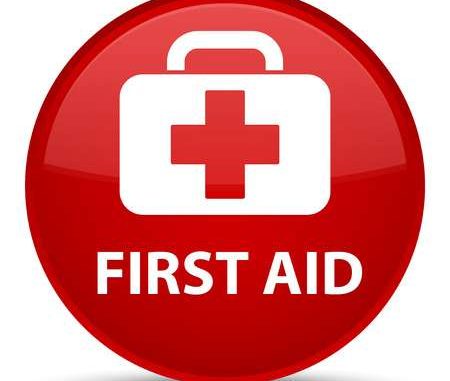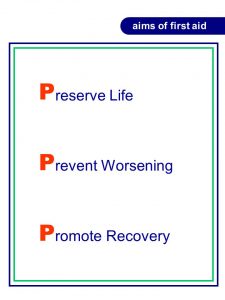
Table of Contents
What is First Aid?
- First aid, by its name itself, is the first/immediate/primary assistance and care given to the injured/ill person.
- First aid includes initial intervention/support to the injured person before he/she receives professional medical treatment.
- First aid is a provision of instantaneous carefulness given to an individual if he/she is suffering from pain, injury, illness, shock, or trauma while waiting for complete medical action is made accessible.
- The concept of first aid was developed first time in 1858 in Germany during the war.
Full form of First Aid:
Although, in most of the cases, full forms are not commonly used for First Aid. However, the commonly found abbreviation of first aid is:
F: First
I: Investigation
R: Relief
S: Symptom
T: Treatment
A: Arrangement
I: Immediately
D: Disposal
Aims of First Aid:
- The aim of first aid is commonly remembered as “3 Ps”:
- Prevent further injury
- Preserve life
- Promote recovery

These three themes also reflects all the actions that needs to be carried out by a first aider. Apart from these 3P’s, the other 2P’s of first aid are:
- Make the patient relax
- Protect the unconsciousness of the patient
Primary Things To Be Noted While Giving First Aid:
- A- Airway
- B- Breathing
- C- Circulation (stop bleeding)
- D- Disability
- E- Exposure environment (the condition/environment where patient is found)
Qualities of an Excellent First Aider:
- Should have a helping attitude
- Should be polite and gentle
- Should have the quality of getting/asking help from others, in any necessary cases
- Must be alert that first aider is not a doctor
- Should be a good observer (site of injury, talk to the patient, know the level of consciousness of the patient)
- Should be able to manage the local resources efficiently at the site of injury
- Should be prompt and quick
- Should be calm in nature and able to control emotions
Responsibilities of a First Aider:
- He/she should not leave the patient alone.
- He/she should be able to make the patient relax enough. This will help the patient to not lose his/her consciousness.
- First attention should be given to the mute patient
- He/she should never argue with the patient or patient party.
- He/she should manage the incident and ensure continuing safety of the patient/injured safety.
- While sending patient to the hospital, he/she (first aider) must send detail report to the hospital i.e. site of injury, place of accident, first aid measures taken etc.
Essential Items of A First Aid Box:

- Bandages, roller bandages and tape
- Adhesive tape
- (Sterile) Gauze and eye pads
- Antiseptic wipes and swabs
- Wet wipes
- Absorbent compresses
- Antibiotic cream/ointment
- Painkiller sprays and tablets
- Burn ointment
- Mask for breathing (rescue breathing/CPR)
- Chemical cold pack
- Eye shield and eye wash
- Scissors and tweezers
- Sterile gloves
- Thermometer
- First aid reference guide that includes local hospital/ambulance phone numbers
References and For More Information:
https://firstaidtrainingcooperative.co.uk/responsibilities-of-a-first-aider-2/ https://www.usc.edu.au/connect/work-at-usc/health-safety-and-wellbeing/workplace-safety/first-aid-management-protocol
https://www.mayoclinic.org/first-aid/first-aid-poisoning/basics/art-20056657
https://www.mayoclinic.org/first-aid/first-aid-snake-bites/basics/art-20056681
https://www.thehealthsite.com/diseases-conditions/first-aid-in-a-road-traffic-accident-51991/
https://www.paradisefirstaid.com.au/drowning-first-aid/
https://www.mayoclinic.org/first-aid/first-aid-fractures/basics/art-20056641
https://www.webmd.com/first-aid/mountain-sickness-treatment
https://pediatrics.aappublications.org/content/143/5/e20190850
https://patient.info/doctor/accidents-and-their-prevention
https://nhcps.com/lesson/cpr-first-aid-first-aid-basics/
https://www.alsco.co.nz/2019/03/aims-first-aid/
https://int.elastoplast.com/instant-help/health-and-protection/first-aid
https://www.webmd.com/first-aid/default.htm